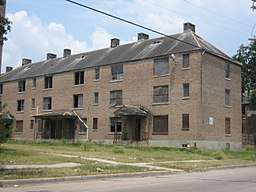Magnolia Projects
| CJ Peete Housing Devolpment | |
| Magnolia Housing Projects | |
| New Orleans Neighborhood | |
 Magnolia housing Projects 2003 | |
| Country | United States |
|---|---|
| State | Louisiana |
| City | New Orleans |
| Police District | District 6, Central City |
| Elevation | 0 ft (0.0 m) |
| Coordinates | 29°56′19″N 90°05′38″W / 29.93861°N 90.09389°WCoordinates: 29°56′19″N 90°05′38″W / 29.93861°N 90.09389°W |
| Area | 0.30 sq mi (0.8 km2) |
| - land | 0.30 sq mi (1 km2) |
| - water | 0.00 sq mi (0 km2), 0% |
| Population | 379 (2010) |
| Density | 1,263/sq mi (488/km2) |
| Timezone | CST (UTC-6) |
| - summer (DST) | CDT (UTC-5) |
| Area code | 504 |
|
Magnolia Street Housing Project | |
  | |
| NRHP reference # | 99001038 |
|---|---|
| Added to NRHP | 1999[1] |
The Magnolia Projects, officially the C.J. Peete Projects was one of the Housing Projects of New Orleans. As part of the ongoing redevelopment, the area has been renamed Harmony Oaks. The project was among the largest, housing approximately 2,100 people. It is infamous nationwide for both high violent-crime rates as well as spawning a number of Hip Hop artists. They referred to it as "Magnolia: Home of the Soulja." Located in the part of Uptown New Orleans known as Central City, it was bounded by Louisiana Avenue, South Claiborne Avenue, La Salle Street and Washington Avenue. The Magnolia Projects are located within the 11th and 12th Wards of New Orleans. At its height, the Magnolia projects had 1403 units.
History
The first part of the project was constructed in 1941, bordered by Louisiana Avenue, Magnolia Street, Washington Avenue and LaSalle Street. In 1955, the complex was expanded north past Clara Street, incorporating about six additional city blocks. Toledano Street was re-aligned during the 1955 expansion, resulting in the disappearance of a three block long residential street named Belmont Place. The only remnants of Belmont Place are three houses facing Toledano before it joins with Louisiana Avenue. During the Jim Crow laws era of racial segregation, the city's main medical care facility for African-Americans, Flint Goodridge Hospital, was on the southwest end of the Magnolia on Louisiana Avenue. The first three African American mayors of New Orleans were born at Flint Goodridge. From 1952 through 1978, the manager was Cleveland Joseph Peete. In the 1980s and 1990s conditions in the projects had been neglected and declined severely. In 1998 demolition of portions of the projects began as part of a Housing Authority of New Orleans (HANO) revitalization plan.
By 2005, only the 1955 expansion had been razed. The majority of the remaining buildings were vacant and fenced off, with only a portion still occupied, when the area flooded in the aftermath of Hurricane Katrina (see: Effects of Hurricane Katrina in New Orleans). Redevelopment work has been delayed in the aftermath of the disastrous flood which devastated the majority of the city. As of late 2008, the Magnolia Projects had been vacated and the majority of buildings razed.On January 7, 2009, local, state, federal and HUD officials met to break ground on a new $183 million C.J. Peete community meant to replace the Magnolia Projects.[2] The plans include 460 units, a Recovery School District school and YMCA in the first phase. 2/3 of the community will be mixed-use and mixed-income, with the rest being market value apartments and town homes.
In 2011, the rebranded Harmony Oaks community developed by McCormack Baron Salazar opened as a mixed-use community of 460 apartments and homes including public housing, low income and market-rate dwellings. The new Harmony Oaks, redeveloped on the old Magnolia Projects site, is located on some 41 acres southeast of the intersection of Claiborne and Louisiana Aves. The site is bounded by Washington Ave. to the east, LaSalle St. and Freret St. to the south, Louisiana and Toledano Aves. to the west, and S. Claiborne Ave. to the north.[3] The redeveloped projects is a continuation of New Orleans' move towards new urbanism favoring urban neighborhood development over suburban sprawl.[4]
Crime
The Magnolia Projects had one of the highest crime rates in the United States and was one the poorest projects in New Orleans. [5] The average cost of living in the project was $50 per month and was overfilled with low-income families. Violence became a key issue with murder being the main problem for residents who lived there. For many years police did little to no effort patrolling the project, most were described as dirty which lead to some residents not trusting law enforcement. In 1987 NOPD described the Magnolia as a "war zone filled with gangsters and drug dealers." Conditions in the Magnolia were close to deplorable as 50% of its units were abandoned and boarded off. The unoccupied apartment units attracted squatters, drug addicts and children. The children would play games like hide and seek and discover bullet-riddled bodies decomposing. Thugs would also hide weapons and narcotics inside.[6] The project was also the breeding grounds for the Dooney Boys and Byrd Gang two of the city's most lethal gangs. Both organizations had a fearsome reputation in the streets and claimed the magnolia as their home for may years.[7][8] The vicious gang were involved in many high-profile murders in Houston and Atlanta.[9] Rapper Soulja Slim was allegedly a known affiliate of the gang was shot to death in 2003.[10] After Hurricane Katrina the new Magnolia known as "Harmony Oaks," opened and only allowed some of the old residents to move back in. To make it safer, the landlords began taking a harder line on policies, mandating a one-strike rule for residents when it comes to violating lease agreements.[11]
Cultural contributions
The various New Orleans housing projects are most notable for being the launching ground for Bounce Music and New Orleans Rap. The most well-known artists to come out of the Magnolia Projects are Juvenile (rapper) and Turk (rapper) of the Hot Boys, a former rap group who started their careers on Cash Money Records, as well as rapper Jay Electronica. The label shot to fame in the late 1990s and still are popular today. Other popular artists from the area include Soulja Slim and Mr. Marcelo. The district is often referred to as Magnolia or Nolia. The Magnolia has been the scene of Juvenile's hit song "Nolia Clap", a dance inspired solely by the Magnolia Projects. The Magnolia Projects has also been home to sculptor Willie Birch. The park on La Salle in the Projects, A.L. Davis Park (named after Abraham Lincoln Davis, the first African-American to serve on the New Orleans City Council), has long been a frequent site of brass band parades, and an important gathering site for Mardi Gras Indians tribes. Under the old name of "Shakespere Park" (originally commemorating New Orleans mayor Joseph A. Shakspeare) it is mentioned in the lyrics of Professor Longhair and Papa Celestin. The housing project was also mentioned in Playboi Carti's song, "Magnolia", released in 2017, on his self-titled debut project.
References
- ↑ National Park Service (2007-01-23). "National Register Information System". National Register of Historic Places. National Park Service.
- ↑ "Archived copy". Archived from the original on 2009-02-19. Retrieved 2009-01-07.
- ↑ Harmony Oaks, Housing Authority of New Orleans (HANO), January 2012.
- ↑ The architecture of New Orleans public housing, NOLA.com, February 13, 2011.
- ↑ https://newsone.com/1555245/most-infamous-public-housing-projects/
- ↑ Hayward, Jeff (June 21, 1990). "A murder in the Magnolia projects".
- ↑ https://www.nola.com/news/index.ssf/2009/04/carnival_shooting_details_emer.html
- ↑ https://boxden.com/showthread.php?t=1877477
- ↑ http://content.time.com/time/nation/article/0,8599,1154134,00.html
- ↑ http://moderntribalist.blogspot.com/2006/03/man-linked-to-3-houston-murders-now.html
- ↑ http://www.galvnews.com/article_98b639d4-28c2-11e3-8939-001a4bcf6878.html
External links
| Wikimedia Commons has media related to Magnolia Projects. |
